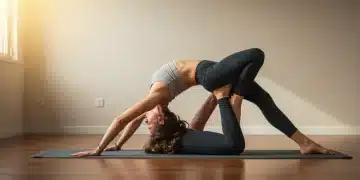Avoid Yoga Injuries: Expert Tips on Posture Mistakes

Avoid these five common yoga posture mistakes that can lead to injury by focusing on proper alignment, listening to your body, and modifying poses as needed, ensuring a safe and beneficial yoga practice.
Yoga is a fantastic way to improve flexibility, strength, and mental well-being. However, incorrect form can lead to injuries. Avoid these five common yoga posture mistakes with expert advice for a safe practice.
Understanding the Importance of Proper Yoga Alignment
Proper alignment in yoga is crucial for preventing injuries and maximizing the benefits of each pose. When your body is correctly aligned, you distribute weight evenly and avoid unnecessary strain on joints and muscles. Understanding these principles is key to a sustainable and enjoyable yoga practice.
Why Alignment Matters
Alignment isn’t just about aesthetics; it’s about biomechanics. Correct alignment ensures that the right muscles are engaged, and your joints are protected.
Common Misconceptions About Yoga
Many beginners believe that flexibility is the most important aspect of yoga. While flexibility is beneficial, stability and proper alignment are more important, especially in preventing injuries.
- Joint Protection: Proper alignment minimizes stress on joints, such as knees, hips, and spine.
- Muscle Engagement: Correct alignment ensures that the appropriate muscles are working, which can improve strength and stability.
- Injury Prevention: Practicing poses with proper alignment significantly reduces the risk of strains, sprains, and chronic pain.
- Improved Balance: Good alignment improves balance and stability, making poses more accessible and enjoyable.
Focusing on alignment not only safeguards your body from potential harm but also allows you to deepen your practice and experience the full benefits of each pose. Take the time to understand the correct alignment for each pose, and don’t hesitate to use props or modifications to support your body.

Mistake #1: Hyperextending the Knees
Hyperextending the knees is a common mistake that can lead to knee joint instability and pain. This occurs when you lock your knees, causing the joint to extend beyond its normal range of motion.
How to Identify Hyperextension
Visually, hyperextension appears as a slight backward bend in the knee. You might also feel a sensation of locking or stiffness in the joint.
Poses Where This Often Happens
Poses like Warrior II, Triangle Pose, and even Tadasana (Mountain Pose) are common culprits for knee hyperextension.
- Micro-bend: Maintain a slight bend in your knees to engage the surrounding muscles and protect the joint.
- Muscle Engagement: Focus on engaging your quadriceps and hamstrings to support the knee joint.
- Prop Use: If needed, use a slight bend in the knee for support and stability.
- Mindful Awareness: Pay close attention to the sensation in your knees and adjust accordingly.
Being mindful of your knee position in yoga poses and actively preventing hyperextension can save you from potential discomfort and long-term knee problems. By engaging the appropriate muscles and maintaining a slight bend, you create a stable and safe foundation for your practice.
Mistake #2: Rounding the Back in Forward Folds
Rounding the back in forward folds, such as Uttanasana (Standing Forward Bend), can put excessive strain on the lumbar spine and lead to back pain. It’s more important to maintain a straight spine than to touch your toes.
The Dangers of a Rounded Back
Rounding the back compresses the vertebrae and can lead to disc issues, muscle strains, and nerve impingement.
How to Modify Forward Folds
To protect your back, focus on bending from the hips and keeping your spine long. If necessary, bend your knees to maintain a straight back.
- Bend Your Knees: Allow a generous bend in your knees to prioritize a straight spine.
- Engage Core Muscles: Activating your core muscles provides support and stability to your spine.
- Use Props: Use blocks under your hands to reduce the distance to the floor while maintaining a straight back.
- Focus on Lengthening: Imagine lengthening your spine from the crown of your head to your tailbone.
Maintaining a straight spine in forward folds is crucial for protecting your back and maximizing the benefits of the pose. By bending your knees, engaging your core, and using props, you can ensure a safe and effective practice that supports your spinal health.
Mistake #3: Misaligning the Shoulders in Plank Pose
Plank pose is a foundational posture in yoga, but improper alignment, particularly in the shoulders, can lead to wrist strain and shoulder impingement. The key is to ensure your shoulders are directly over your wrists and your body forms a straight line from head to heels.
Common Alignment Problems
Often, people either sag in the midsection or hike their hips too high, disrupting the alignment of the shoulders and wrists.
Correcting Your Plank
Engage your core, press firmly into your hands, and ensure your shoulders are over your wrists. Imagine a straight line running from your head through your heels.

- Core Engagement: Actively engage your core muscles to prevent sagging in the midsection.
- Hand Placement: Ensure your hands are shoulder-width apart, with fingers spread wide.
- Shoulder Position: Keep your shoulders directly above your wrists to minimize strain.
- Body Awareness: Regularly check your alignment in a mirror or ask an instructor for feedback.
Proper alignment in plank pose is essential for building strength and stability while minimizing the risk of injury. By focusing on core engagement, correct hand placement, and shoulder position, you can transform your plank into a safe and effective posture that benefits your entire body.
Mistake #4: Overextending in Backbends
Backbends, such as Cobra Pose (Bhujangasana) and Bridge Pose (Setu Bandhasana), can be invigorating and beneficial, but overextending can compress the lower back and cause pain. Focus on evenly distributing the bend throughout your spine, rather than just in the lumbar region.
Understanding Spinal Extension
A healthy backbend involves a gentle curve throughout the entire spine, from the neck to the tailbone.
Effective Modifications
Modify poses by focusing on engaging your core and glutes, which supports the spine and prevents overextension in the lower back.
- Core Engagement: Engaging your core muscles provides essential support for the spine.
- Glute Activation: Squeezing your glutes helps lift and support the lower back.
- Controlled Movement: Enter and exit backbends slowly and deliberately.
- Listen to Your Body: Pay attention to any discomfort and adjust the pose accordingly.
Practicing safe and effective backbends involves engaging your core, activating your glutes, and distributing the bend evenly throughout your spine. By listening to your body and making necessary adjustments, you can enjoy the many benefits of backbends without risking injury to your lower back.
Mistake #5: Holding Your Breath
Holding your breath during yoga is a common mistake that can limit the benefits of the practice and even increase blood pressure. Conscious, steady breathing is an integral part of yoga and helps to calm the mind and body.
The Importance of Breath
Breathing, or Pranayama, is a fundamental aspect of yoga. It helps to regulate the nervous system, increase oxygen flow, and deepen your connection to the present moment.
Breathing Techniques
Practice Ujjayi breath (ocean breath) or simply focus on long, deep inhales and exhales. Ensure your breath remains smooth and controlled throughout your practice.
- Ujjayi Breath: Practice Ujjayi breath to maintain focus and calm the mind.
- Diaphragmatic Breathing: Focus on breathing deeply into your belly to fully expand your lungs.
- Synchronize Breath with Movement: Coordinate your breath with each movement to enhance the flow of your practice.
- Mindful Awareness: Pay attention to your breath and adjust your pace as needed.
Conscious breathing is a cornerstone of yoga practice. By focusing on techniques like Ujjayi breath, synchronizing breath with movement, and staying mindfully aware of your breath, you can enhance the benefits of your practice and promote overall well-being.
| Key Point | Brief Description |
|---|---|
| ⚠️ Hyperextending Knees | Keep a micro-bend in knees to prevent joint stress. |
| 🤕 Rounding Back | Bend knees in forward folds to maintain a straight spine. |
| 😬 Misaligned Shoulders | Align shoulders over wrists in plank for stability. |
| 😮💨 Holding Breath | Breathe deeply and consistently during yoga. |
Frequently Asked Questions
▼
Proper alignment prevents injuries by distributing weight evenly, reducing strain on joints, and engaging the correct muscles. It also enhances the benefits of each pose.
▼
Maintain a slight bend in your knees, engage your quadriceps and hamstrings, and pay close attention to the sensation in your knees. Avoid locking the knees.
▼
Bend your knees generously, engage your core, and use props like blocks to maintain a straight spine. Focus on bending from the hips, not the lower back.
▼
Ensure your shoulders are directly over your wrists and your body forms a straight line from head to heels. Engage your core and press firmly into your hands.
▼
Holding your breath can limit the benefits of yoga, increase blood pressure, and prevent you from calming your mind and body. Focus on steady, conscious breathing.
Conclusion
By being mindful of these common yoga posture mistakes and actively working to correct them, you can ensure a safer, more effective, and more enjoyable yoga practice. Remember to listen to your body, use modifications when needed, and prioritize proper alignment over achieving the “perfect” pose.





